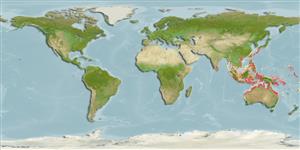Environment: milieu / climate zone / depth range / distribution range
Ecologie
marien; brak water rifbewoner; diepte 1 - 20 m (Ref. 90102). Tropical
Indo-West Pacific: Indo-Australian Archipelago. Known from the Mekong delta (Ref. 12693).
Grootte / Gewicht / Leeftijd
Maturity: Lm ? range ? - ? cm
Max length : 28.0 cm TL mannelijk / geslacht onbekend; (Ref. 90102); max. gepubliceerd gewicht: 400.00 g (Ref. 3132)
Dorsale stekels (totaal): 3; Dorsale zachte stralen (totaal): 19-21; Anale stekels 0; Anale zachte stralen: 16 - 18; Wervels: 27 - 28.
Found in coastal reefs and among mangroves, sometimes in crevices or caves (Ref. 9710). Occurs in estuaries and fairly common in the tidally influenced part of the lower Mekong (Ref. 12693). Conceals itself in mud or debris and waits for prey to come by (Ref. 12693). Feeds on crabs, prawns, mollusks, echinoderms, and fishes. Stab wounds from spines can result to severe pain. Rarely trawled. Marketed fresh in the Mekong delta (Ref. 12693).
Levenscyclus en paargedrag
Maturiteit | Voortplanting | Paaien | Eieren | Fecunditeit | Larven
Allen, G.R. and R. Swainston, 1988. The marine fishes of north-western Australia: a field guide for anglers and divers. Western Australian Museum, Perth. 201 p. (Ref. 3132)
Status op de Rode Lijst van het IUCN (Ref. 130435)
Gevaar voor de mens
Harmless
Gebruik door de mens
Meer informatie
Lokale namenSynoniemenMetabolismePredatorenEcotoxicologieVoortplantingMaturiteitPaaienPaaiaggregatiesFecunditeitEierenOntwikkeling van de eieren
ReferentiesAquacultuurAquacultuurprofielKweeklijnenGeneticaElectrophoresesErfelijkheidZiektesVerwerkingNutrientsMassaconversie
Tools
Speciale rapporten
Download XML
Internetbronnen
Estimates based on models
Preferred temperature (Ref.
123201): 24.8 - 29.3, mean 28.6 °C (based on 2393 cells).
Fylogenetische diversiteitsindex (Ref.
82804): PD
50 = 0.5625 [Uniqueness, from 0.5 = low to 2.0 = high].
Bayesian length-weight: a=0.00389 (0.00180 - 0.00842), b=3.12 (2.94 - 3.30), in cm total length, based on all LWR estimates for this body shape (Ref.
93245).
Trofisch niveau (Ref.
69278): 3.7 ±0.56 se; based on food items.
Weerstandsvermogen (Ref.
120179): Gemiddeld, minimale populatieverdubbelingstijd 1,4-4,4 jaar (Preliminary K or Fecundity.).
Fishing Vulnerability (Ref.
59153): Low vulnerability (18 of 100).
Nutrients (Ref.
124155): Calcium = 58.4 [32.1, 118.3] mg/100g; Iron = 0.535 [0.309, 0.948] mg/100g; Protein = 18.2 [17.1, 19.4] %; Omega3 = 0.11 [0.06, 0.19] g/100g; Selenium = 25 [13, 52] μg/100g; VitaminA = 113 [39, 320] μg/100g; Zinc = 1.57 [1.08, 2.18] mg/100g (wet weight);
